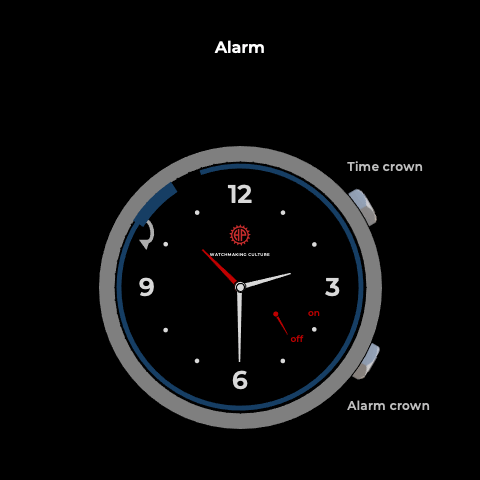THE ALARM COMPLICATION
Alarms and striking mechanisms can be considered among the oldest horological complications, having existed on early clocks even before the introduction of dials and hands.
In wristwatches, as well as in clocks or traditional morning alarm clocks, an alarm mechanism requires an independent power source—typically a dedicated mainspring barrel, along with a separate gear train and a speed governor.
Winding the alarm and setting the desired alarm time is usually done via a dedicated crown, which often also serves as the on/off switch for the chime. The alarm time is indicated by a central hand, positioned beneath the main hour hand. Both hands are fixed to separate concentric cannon pinions, stacked one on the other. The alarm hand’s cannon pinion features a trigger finger, while the main hour hand’s cannon pinion has a recessed notch. When the two hands align perfectly—i.e. at the preset alarm time—the alarm finger drops into the notch, which releases the alarm mechanism and activates the striking system.
The energy stored in the alarm barrel is then released through its gear train, rotating at high speed, ultimately powering a rapidly oscillating hammer. A simplified form of escapement typically controls this hammer and may strike a gong or, in simpler constructions, the inside of the case.
The speed of the alarm gear train is regulated to ensure a steady strike rhythm and a sufficient ringing duration. This regulation may rely on a flywheel with fixed wings or, in more refined systems, on a variable inertia flywheel. In this setup, when energy is abundant and the flywheel spins quickly, the wings move outward under centrifugal force, increasing resistance and slowing the mechanism down. Conversely, when energy decreases, the wings retract closer to the axis, allowing the mechanism to speed up slightly, thereby maintaining a more constant striking speed regardless of the available power.
This type of speed governor is common in many chiming watches. As with any watch equipped with at least one striking mechanism, an activation switch (separate or integrated into the crown) allows the user to enable or silence the alarm. In some models, an indicator hand shows the current state of the alarm (e.g., ring/silent or on/off).

